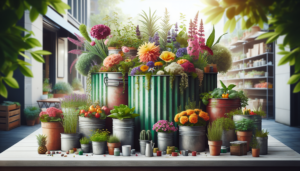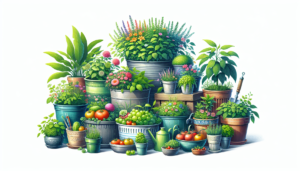
Are you interested in container gardening but unsure how to choose the right liner for your containers? Well, fear not! In this article, we will provide you with useful tips and advice to help you make the perfect choice for your container gardening needs. Whether you are a seasoned gardener or just starting out, selecting the right liner is essential for the health and success of your plants. So, let’s get started!
Material
When it comes to choosing the perfect container gardening liner, the material plays a crucial role in ensuring the longevity and functionality of your garden. There are several materials to choose from, including plastic, fiber, metal, ceramic, and clay. Let’s take a closer look at each of these options.
Plastic
Plastic liners are a popular choice due to their affordability, lightweight nature, and ease of care. They are available in a wide range of colors, shapes, and sizes, making them versatile and suitable for various garden styles. Plastic liners also offer excellent insulation, protecting your plants from extreme temperatures.
Fiber
Fiber liners, such as coconut coir or moss, are organic and environmentally friendly options. These liners promote healthy root growth and moisture retention, creating an ideal environment for your plants. They add a natural and rustic look to your garden and can be easily shaped to fit different containers.
Metal
Metal liners, such as stainless steel or zinc-coated containers, are known for their durability and resistance to harsh weather conditions. They are a great option for long-term use and can withstand heavy plants or trees. Metal liners also provide a sleek and modern aesthetic to your garden.
Ceramic
Ceramic liners offer a more decorative and artistic appeal to your container gardens. They are available in a wide range of colors, patterns, and designs, allowing you to express your creativity and add a unique touch to your space. However, ceramic liners can be heavy and fragile, requiring extra care and attention.
Clay
Clay liners, also known as terracotta, are classic options that have been used for centuries. They are porous, allowing better air circulation and moisture control for your plants. Clay liners are great for those who tend to overwater their plants as they absorb excess moisture. However, they can be prone to cracking in freezing temperatures.
Size
The size of your container gardening liner is another important factor to consider. It directly affects the growth and development of your plants, as well as the overall aesthetics of your garden.
Diameter
The diameter of your liner determines the amount of space available for your plants to spread their roots. If your chosen plants have deep or extensive root systems, opt for larger diameter liners. Smaller diameter liners are suitable for plants with shallow or compact root systems.
Height
The height of your liner determines the depth of soil available for your plants. Consider the growth habits and root depth of your plants when choosing the height of your liner. Taller liners are ideal for plants that require a deep soil profile, while shorter liners are suitable for plants with shorter roots.
Drainage
Good drainage is essential to prevent waterlogging and the development of root rot in your container gardens. When selecting a liner, pay attention to the drainage capabilities it offers.
Presence of Drainage Holes
Ensure that your liner has sufficient drainage holes to allow excess water to escape. These holes prevent the accumulation of water at the bottom of the container, which can suffocate the roots. Look for liners with ample drainage holes evenly distributed throughout the container.
Types of Drainage Holes
Different liners may have varying types of drainage holes. Some liners have pre-drilled holes, while others may have perforated patterns on the sides or bottom. Consider the specific needs of your plants and choose a liner with drainage holes that match those needs.
Overflow Mechanism
In addition to drainage holes, some liners come with overflow mechanisms to redirect excess water away from your plants. These mechanisms help prevent water buildup during heavy rainfall or overwatering. Consider liners with built-in overflow mechanisms if you live in an area with frequent rain or tend to overwater your plants.
Durability
The durability of your container gardening liner ensures its longevity and ability to withstand various weather conditions. Consider the following factors when assessing the durability of different liner materials.
Resistance to Weather
Choose a liner that can withstand the specific weather conditions of your region. Plastic liners are generally more resistant to extreme temperatures, including hot summers and freezing winters. Metal liners, such as stainless steel or zinc-coated containers, are highly durable and can withstand harsh weather conditions. Ceramic and clay liners may require extra care and protection during freezing temperatures to prevent cracking.
Longevity
Consider the lifespan of the liner material when making your selection. Plastic liners are relatively inexpensive but may degrade over time due to exposure to sunlight and UV rays. Metal liners are long-lasting and can withstand years of use. Ceramic and clay liners can also last a long time with proper care, but they are more susceptible to breakage.
Insulation
The insulation properties of your container gardening liner play a crucial role in regulating the temperature and protecting your plants from extreme weather conditions.
Temperature Regulation
Different liner materials have varying insulation capabilities. Plastic liners provide excellent insulation, protecting your plants from extreme heat or cold. Metal liners may absorb and retain heat, making them suitable for plants that prefer warmer conditions. Ceramic and clay liners offer natural insulation, helping to regulate temperature changes for your plants.
Protection from Extreme Weather Conditions
In addition to insulation, some liner materials offer extra protection from extreme weather conditions. Plastic liners are resistant to cracking and fading under sunlight, making them suitable for outdoor gardens exposed to the elements. Metal liners are highly durable and can withstand strong winds and heavy rains. Ceramic and clay liners may require additional protection during freezing temperatures to prevent cracking.
Weight
Consider the weight of your container gardening liner, as it affects the ease of mobility and suitability for certain locations.
Ease of Mobility
If you plan to move your containers frequently, opt for lightweight liner materials such as plastic or fiber. These materials are easy to lift and transport, making them suitable for those who enjoy rearranging their garden or need to relocate their plants.
Suitability for Balconies and Rooftops
If you intend to place your containers on balconies or rooftops, consider the weight restrictions of these structures. Plastic or fiber liners are generally lighter and put less strain on these areas compared to heavy metal, ceramic, or clay liners.
Aesthetics
The aesthetic appeal of your container gardening liner contributes to the overall beauty and style of your garden. Consider the following aspects when selecting a liner based on aesthetics.
Color Options
Different materials offer a wide range of color options to suit your personal preferences and match your garden theme. Plastic liners come in various vibrant colors, allowing you to create eye-catching displays. Metal liners often have a sleek and modern appearance, while ceramic and clay liners offer more traditional and rustic tones.
Texture and Design
In addition to color, consider the texture and design of your liner. Plastic liners can mimic the texture of natural materials such as wood or stone. Metal liners may have unique patterns or textures that add visual interest. Ceramic and clay liners often feature handcrafted designs or intricate details that can be a focal point in your garden.
Price
Consider your budget when choosing a container gardening liner. Different materials and sizes offer varying price ranges, so it’s essential to find the best value for your money.
Budget Considerations
Plastic and fiber liners are generally more affordable options, making them suitable for those on a tight budget. Metal, ceramic, and clay liners tend to be more expensive due to their durability and aesthetic appeal. Consider the long-term investment and lifespan of the liner material when evaluating the price.
Value for Money
While price is an important factor, also consider the value for money when choosing a liner. A liner that offers durability, functionality, and aesthetic appeal may justify a higher price tag. Consider your specific needs and preferences, and choose a liner that provides the best value for your gardening investment.
Maintenance
The maintenance requirements of your container gardening liner affect the cleanliness and overall health of your plants. Consider the following factors when evaluating the maintenance needs of different liner materials.
Cleanability
Plastic, fiber, and metal liners are generally easy to clean with a simple rinse or wipe. They are less prone to staining and can be quickly restored to their original condition. Ceramic and clay liners may require more effort to clean due to their porous nature. Regular scrubbing and occasional deep cleaning may be necessary to remove dirt or mineral deposits.
Prevention of Mold and Mildew
Good airflow and drainage play important roles in preventing the development of mold and mildew in your container garden. Plastic, metal, and fiber liners offer excellent airflow and drainage capabilities, minimizing the risk of moisture-related issues. Ceramic and clay liners may require additional attention to ensure proper airflow and prevent excessive moisture buildup.
Compatibility with Plants
Consider the specific needs of your plants when selecting a container gardening liner. Different liner materials offer varying levels of support and benefits for your plants’ growth and development.
Root Development
Some plants have extensive or deep-rooted systems that require ample space to grow. Opt for larger diameter and taller liners that accommodate the specific root depth and expansion of your chosen plants. Fiber and clay liners, in particular, promote healthy root development by allowing better air circulation and moisture control.
Moisture Retention
Certain plants are more sensitive to water availability and require a liner that retains moisture. Fiber liners, such as coconut coir or moss, are excellent at retaining moisture, ensuring your plants have a steady water supply. Plastic liners with good drainage capabilities can also retain enough moisture without causing root rot.
Support for Climbing Plants
If you plan to grow climbing plants, choose a liner that provides adequate support. Materials such as plastic, fiber, or metal can offer sturdy structures for climbing plants to anchor onto. Consider adding trellises or support systems in conjunction with your liner to ensure the proper growth of climbing plants.
In conclusion, selecting the perfect container gardening liner involves considering various factors such as material, size, drainage, durability, insulation, weight, aesthetics, price, maintenance, and compatibility with plants. By evaluating these aspects and understanding your specific gardening needs, you can find a liner that enhances the beauty of your plants while providing the necessary support and functionality for a thriving garden. Happy gardening!







